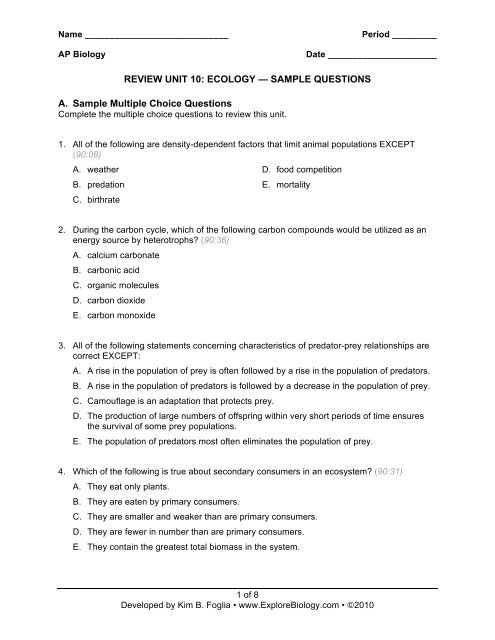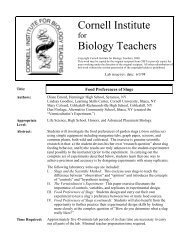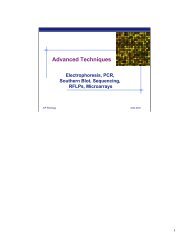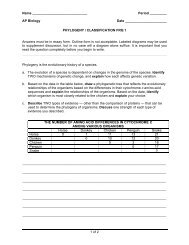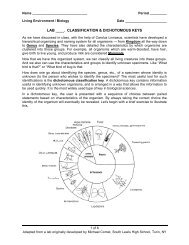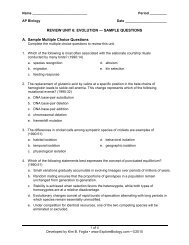REVIEW UNIT 10: ECOLOGY â SAMPLE ... - Explore Biology
REVIEW UNIT 10: ECOLOGY â SAMPLE ... - Explore Biology
REVIEW UNIT 10: ECOLOGY â SAMPLE ... - Explore Biology
Create successful ePaper yourself
Turn your PDF publications into a flip-book with our unique Google optimized e-Paper software.
Name _____________________________<br />
AP <strong>Biology</strong><br />
Period _________<br />
Date ______________________<br />
<strong>REVIEW</strong> <strong>UNIT</strong> <strong>10</strong>: <strong>ECOLOGY</strong> — <strong>SAMPLE</strong> QUESTIONS<br />
A. Sample Multiple Choice Questions<br />
Complete the multiple choice questions to review this unit.<br />
1. All of the following are density-dependent factors that limit animal populations EXCEPT<br />
(90:08)<br />
A. weather D. food competition<br />
B. predation E. mortality<br />
C. birthrate<br />
2. During the carbon cycle, which of the following carbon compounds would be utilized as an<br />
energy source by heterotrophs? (90:36)<br />
A. calcium carbonate<br />
B. carbonic acid<br />
C. organic molecules<br />
D. carbon dioxide<br />
E. carbon monoxide<br />
3. All of the following statements concerning characteristics of predator-prey relationships are<br />
correct EXCEPT:<br />
A. A rise in the population of prey is often followed by a rise in the population of predators.<br />
B. A rise in the population of predators is followed by a decrease in the population of prey.<br />
C. Camouflage is an adaptation that protects prey.<br />
D. The production of large numbers of offspring within very short periods of time ensures<br />
the survival of some prey populations.<br />
E. The population of predators most often eliminates the population of prey.<br />
4. Which of the following is true about secondary consumers in an ecosystem? (90:31)<br />
A. They eat only plants.<br />
B. They are eaten by primary consumers.<br />
C. They are smaller and weaker than are primary consumers.<br />
D. They are fewer in number than are primary consumers.<br />
E. They contain the greatest total biomass in the system.<br />
1 of 8<br />
Developed by Kim B. Foglia • www.<strong>Explore</strong><strong>Biology</strong>.com • ©20<strong>10</strong>
Name _____________________________<br />
AP <strong>Biology</strong><br />
5. In the nitrogen cycle, the transformation of gaseous nitrogen into nitrogen-containing<br />
compounds is performed primarily by (90:35)<br />
A. fungi<br />
B. bacteria<br />
C. green plants<br />
D. herbivores<br />
E. carnivores<br />
A. tropical rain forest<br />
B. taiga<br />
C. arctic tundra<br />
D. temperate grassland<br />
E. desert<br />
6. Permafrost; temperatures range from approximately -50°C to +25°C; a growing season of 60<br />
days or less (90:91)<br />
7. Over <strong>10</strong> inches of precipitation per year; long, cold winters and short summers; dominant<br />
vegetation is gymnosperm (90:92 modified)<br />
8. Lack of water common in summer; seasonal temperature variations; maintained by periodic<br />
fires (90:93)<br />
9. Less than <strong>10</strong> inches of precipitation per year; extremes of hot and cold throughout the year;<br />
large daily temperature variations (90:94)<br />
<strong>10</strong>. This biome has the greatest diversity of species. (99:80)<br />
11. Which point on the curve in the diagram above best represents the carrying capacity of the<br />
environment for the population shown. (99:01)<br />
A. A<br />
B. B<br />
C. C<br />
D. D<br />
E. E<br />
2 of 8<br />
Developed by Kim B. Foglia • www.<strong>Explore</strong><strong>Biology</strong>.com • ©20<strong>10</strong>
Name _____________________________<br />
AP <strong>Biology</strong><br />
Questions 12–14. refer to the food web below. (90:<strong>10</strong>6-<strong>10</strong>8)<br />
12. Which of the following organisms is most likely to<br />
be located at the apex of the pyramid of biomass?<br />
(90:<strong>10</strong>6)<br />
A. grass<br />
B. grasshopper<br />
C. snake<br />
D. mouse<br />
E. hawk<br />
13. All of the following statements about the diagram are correct EXCEPT: (90:<strong>10</strong>7)<br />
A. The grasshopper is an herbivore.<br />
B. Only two trophic levels are depicted.<br />
C. The mouse and grasshopper are at the same trophic level.<br />
D. The grass is a producer.<br />
E. All of the organisms except grass are consumers, regardless of position.<br />
14. The organic and inorganic materials in all the organisms in the diagram will eventually return<br />
to the environment by the action of (90:<strong>10</strong>8)<br />
A. decomposers<br />
B. producers<br />
C. primary consumers<br />
D. secondary consumers<br />
E. top carnivores<br />
15. Which of the following best explains why there are seldom more than five trophic levels in a<br />
food chain? (94:11)<br />
A. Most carnivores function at more than one trophic level.<br />
B. Trophic levels above this number contain too many individuals.<br />
C. Top carnivores are too few in number to prey effectively.<br />
D. The ecosystem contains too much biomass.<br />
E. Energy is lost from each trophic level.<br />
3 of 8<br />
Developed by Kim B. Foglia • www.<strong>Explore</strong><strong>Biology</strong>.com • ©20<strong>10</strong>
Name _____________________________<br />
AP <strong>Biology</strong><br />
Questions 43–46. The illustrations below show the age and sex of the human populations in<br />
Country 1 and Country 2. The ages are grouped by 5-year classes, and the sexes are<br />
represented separately. The percentages in the different age classes are shown by the relative<br />
widths of successive horizontal bars. (94:<strong>10</strong>9-112)<br />
16. In Country 1, approximately what percentage of the individuals were younger than fifteen<br />
years of age? (94:<strong>10</strong>9)<br />
A. <strong>10</strong>%<br />
B. 21%<br />
C. 42%<br />
D. 52%<br />
E. It cannot be estimated from the graph.<br />
17. Which of the following best approximates the ratio of males to females among individuals<br />
below fifteen years of age? (94:1<strong>10</strong>)<br />
Country 1 Country 2<br />
A. 1 : 1 1 : 1<br />
B. 0.75 : 1 0.75 : 1<br />
C. 0.5 : 1 0.5 : 1<br />
D. 1 : 1 0.5 : 1<br />
E. 0.75 : 1 1 : 1<br />
4 of 8<br />
Developed by Kim B. Foglia • www.<strong>Explore</strong><strong>Biology</strong>.com • ©20<strong>10</strong>
Name _____________________________<br />
AP <strong>Biology</strong><br />
18. If, in Country 1, infant mortality declined and the birth rate remained the same, then initially<br />
the population would be expected to (94:111)<br />
A. be more evenly distributed among the age classes<br />
B. be even more concentrated in the young age classes<br />
C. stabilize at the illustrated level for all age classes<br />
D. increase in the oldest age classes<br />
E. increase in the median age classes<br />
19. Over the next <strong>10</strong>-15 years, the stabilization of Country 1’s population at its current size<br />
would require that (94:112)<br />
A. infant mortality be reduced to about half the present level<br />
B. the death rate be reduced drastically<br />
C. each couple produce fewer children than the number required to replace themselves<br />
D. about 15 years be added to the life expectancy of each person<br />
E. couples have an average of only 3 children<br />
Questions 20–21. The graph below shows changes in a population of wild sheep that were<br />
introduced to the island of Tasmania in the early 1800s. (99:117–120)<br />
20. The type of population growth represented by<br />
that portion of the graph line enclosed in the<br />
bracket is most accurately termed (99:117)<br />
A. stable<br />
B. exponential<br />
C. density-dependent<br />
D. arithmetic<br />
E. decelerating<br />
21. The graph indicates that the sheep population most likely is (99:118)<br />
A. growing in excess of its carrying capacity, since fluctuations in population size occurred<br />
after 1850<br />
B. headed for extinction because of the population explosion about 1930<br />
C. regulated by density-independent factors, because there appears to be about a <strong>10</strong>-year<br />
cycle of sharp declines in size<br />
D. shifting from K-selected strategy to an r-selected strategy<br />
E. stable after 1850 under the effects of density-dependent regulating factors<br />
5 of 8<br />
Developed by Kim B. Foglia • www.<strong>Explore</strong><strong>Biology</strong>.com • ©20<strong>10</strong>
Name _____________________________<br />
AP <strong>Biology</strong><br />
B. Sample Free Response Questions<br />
1. 2006:2<br />
According to fossil records and recent published observations, two species of leaf-eating<br />
beetles (species A and B) have existed on an isolated island in the Pacific Ocean for over<br />
<strong>10</strong>0,000 years. In 1964 a third species of leaf-eating beetle (species C) was accidentally<br />
introduced on the island. The population size of each species has been regularly monitored as<br />
shown in the graph above.<br />
a. Propose an explanation for the pattern of population density observed in species C.<br />
b. Describe the effect that the introduction of beetle species C has had on the population<br />
density of species A and species B. Propose an explanation for the patterns of<br />
population density observed in species A and in species B.<br />
c. Predict the population density of species C in 2014. Provide a biological explanation for<br />
your prediction.<br />
d. Explain why invasive species are often successful in colonizing new habitats.<br />
2. 2007:4<br />
The energy flow in ecosystems is based on the primary productivity of autotrophs.<br />
a. Discuss the energy flow through an ecosystem and the relative efficiency with which it<br />
occurs.<br />
b. Discuss the impact of the following on energy flow on a global scale<br />
<br />
<br />
Deforestation<br />
Global climate change<br />
6 of 8<br />
Developed by Kim B. Foglia • www.<strong>Explore</strong><strong>Biology</strong>.com • ©20<strong>10</strong>
Name _____________________________<br />
AP <strong>Biology</strong><br />
3. 2004:4<br />
Organisms rarely exist alone in the natural environment. The following are five examples of<br />
symbiotic relationships.<br />
Plant root nodules Epiphytic plants<br />
Digestion of cellulose Anthrax<br />
<br />
AIDS (acquired immune deficiency syndrome)<br />
Choose FOUR of the above and for each example chosen,<br />
a. identify the participants involved in the symbiosis and describe the symbiotic<br />
relationship, and<br />
b. discuss the specific benefit or detriment, if any, that each participant receives from the<br />
relationship.<br />
4. 2007:3<br />
Compared with other terrestrial biomes, deserts have extremely low productivity.<br />
a. Discuss how temperature, soil composition, and annual precipitation limit productivity in<br />
deserts.<br />
b. Describe a four-organism food chain that might characterize a desert community, and<br />
identify the trophic level of each organism.<br />
c. Describe the results depicted in the graph. Explain one anatomical difference and one<br />
physiological difference between species A and B that account for the CO 2 uptake<br />
patterns shown. Discuss the evolutionary significance of each difference.<br />
7 of 8<br />
Developed by Kim B. Foglia • www.<strong>Explore</strong><strong>Biology</strong>.com • ©20<strong>10</strong>
Name _____________________________<br />
AP <strong>Biology</strong><br />
5. 2008:2<br />
Consumers in aquatic ecosystems depend on producers for nutrition.<br />
a. Explain the difference between gross and net primary productivity.<br />
b. Describe a method to determine net and gross primary productivity in a freshwater pond<br />
over a 24-hour period.<br />
In an experiment, net primary productivity was measured, in the early spring, for water samples<br />
taken from different depths of a freshwater pond in a temperate deciduous forest.<br />
c. Explain the data presented by the graph, including a description of the relative rates of<br />
metabolic processes occurring at different depths of the pond.<br />
d. Describe how the relationship between net primary productivity and depth would be<br />
expected to differ if new data were collected in mid-summer from the same pond.<br />
Explain your prediction.<br />
8 of 8<br />
Developed by Kim B. Foglia • www.<strong>Explore</strong><strong>Biology</strong>.com • ©20<strong>10</strong>


